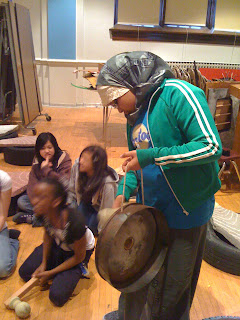















 The applause was (justifiably) wild and everyone went home happy. We had an incredible week as everyone's work reached a climax of perfection. Students, teachers, parents and staff were all proud of the shows that were the culmination of many months planning and dreaming.
The applause was (justifiably) wild and everyone went home happy. We had an incredible week as everyone's work reached a climax of perfection. Students, teachers, parents and staff were all proud of the shows that were the culmination of many months planning and dreaming.
 One week to go until Installation Day and the Rumble Strip is taking (enormous) shape. The poetry is being calligraphed elegantly around the organically-shaped rumble areas. Everything has been glued and painted and the warped plywood has been wetted and flattened, rescuing the whole thing from disaster.
One week to go until Installation Day and the Rumble Strip is taking (enormous) shape. The poetry is being calligraphed elegantly around the organically-shaped rumble areas. Everything has been glued and painted and the warped plywood has been wetted and flattened, rescuing the whole thing from disaster. The Webster poets came up with some watery/sky imagery so their piece now has a name:
The Webster poets came up with some watery/sky imagery so their piece now has a name: Burroughs visited last week to try out the actual instruments. Their piece,
Burroughs visited last week to try out the actual instruments. Their piece,

 Working with the rhythms of our names we tried many combinations of patterns on the gongs. In a small room we couldn't do it for long, and the drums and stones are over at Webster.
Working with the rhythms of our names we tried many combinations of patterns on the gongs. In a small room we couldn't do it for long, and the drums and stones are over at Webster.


 I was hoping the story we all made a few weeks ago could be easily used as the basis for a mimed drama so we started by cutting up the text line by line and making phonetic sounds based on each person's text.
I was hoping the story we all made a few weeks ago could be easily used as the basis for a mimed drama so we started by cutting up the text line by line and making phonetic sounds based on each person's text. After some heavy lifting (the 12 stones that comprise the Flintstone Gamelan weigh over 700lbs, and the car tires they rest on fill a Range Rover), we have some rocking percussion.
After some heavy lifting (the 12 stones that comprise the Flintstone Gamelan weigh over 700lbs, and the car tires they rest on fill a Range Rover), we have some rocking percussion.
 Then we did some exercises clapping the rhythms of our first and last names. When applied to three noisy gongs we achieved some terrific cross-pulses and patterns. Vietnamese E De and Philippine Kulintang use gongs a little bit like this, and now we have our tradition.
Then we did some exercises clapping the rhythms of our first and last names. When applied to three noisy gongs we achieved some terrific cross-pulses and patterns. Vietnamese E De and Philippine Kulintang use gongs a little bit like this, and now we have our tradition.



 With the paint dry on our car tires from last week, we started wrapping thm tightly with Scotch 3M sealing tape to make drums. This proved harder than expected; there's a lot of turning and accuracy involved. Not everyone will get a job at UPS... Some drums are really big and they all sound good together.
With the paint dry on our car tires from last week, we started wrapping thm tightly with Scotch 3M sealing tape to make drums. This proved harder than expected; there's a lot of turning and accuracy involved. Not everyone will get a job at UPS... Some drums are really big and they all sound good together.

 "Sit back to back.
"Sit back to back.




 Painting car tires can be fun and scary; a cool pattern emerges instantly but if you have too much paint it can sink into the cracks and never come out. We tried brushes, pads and eventually brayers (rollers for printmaking).
Painting car tires can be fun and scary; a cool pattern emerges instantly but if you have too much paint it can sink into the cracks and never come out. We tried brushes, pads and eventually brayers (rollers for printmaking). 


 Each of the hard limestone slabs I chose from the stoneyard has areas of maximum resonance, and dud zones. It seems to make no difference whether the stones are supported on the car tires at the nodes or anywhere else, they are so dense.
Each of the hard limestone slabs I chose from the stoneyard has areas of maximum resonance, and dud zones. It seems to make no difference whether the stones are supported on the car tires at the nodes or anywhere else, they are so dense. 
Here's the developing story of Philip Blackburn's sound projects developed for the Flint Hills Children's Festival at the Ordway Theatre in St. Paul, Minnesota. Last year was a Sonic Playground; this year it's the Singing Garden. Here too are extra residency projects that involve making, playing, composing and performing with homemade instruments.
